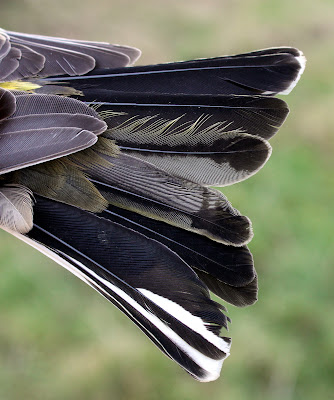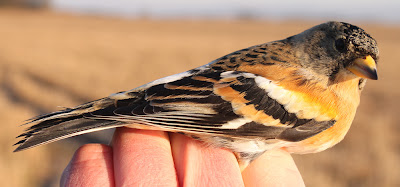There was too little time this morning, no chance of a spot of ringing, just a quick topping up of the bird feeders at Out Rawcliffe, followed by a hurried scoot around the birding block of the farm before the domestics of grandchildren drew me back home.
Shame I didn’t have a couple of hours to spare as there was a good selection of birds in the wood and/or near the bird seed: 60+ Chaffinch, 10+ Brambling, 30+ Goldfinch, 4 Blackbird, 1 Song Thrush, 3 Redwing, 4 Fieldfare, 1 Yellowhammer, 15+ Skylark, 40+ Tree Sparrow, 2 Jay and 25+ Reed Bunting. In fields more distant in the direction of Pilling Moss were 200+ Lapwing and several thousand Pink-footed Goose.
The Reed Buntings here can be quite inquisitive, sitting up in the roadside hawthorns.
Reed Bunting
Reed Bunting
A recurring feature of the last month or two on the inland mosses has been the huge flocks of roving Woodpigeons, pointed out on this blog on a couple of occasions, but barely mentioned in the rest of the blogosphere.
Very recently the number of Woodpigeons appeared to drop, but this morning they were about in their many thousands again, moving in droves between a number of woods and fields in their search for food, the flocks of hundreds and thousands turning the tree tops to a mass of grey. I entered a figure of 15,000 in my notebook but the actual number could be double or more, but whether these are newly arrived birds or part of the original influx is anyone’s guess. No prizes for counting the number of woodies in the shot below, just some of the birds in a single part of just one of many woods the birds used this morning.
A reminder here to anyone new to Blogger, clicking on the pictures gives a light box and slide show, much better than the pictures on the page.
Very recently the number of Woodpigeons appeared to drop, but this morning they were about in their many thousands again, moving in droves between a number of woods and fields in their search for food, the flocks of hundreds and thousands turning the tree tops to a mass of grey. I entered a figure of 15,000 in my notebook but the actual number could be double or more, but whether these are newly arrived birds or part of the original influx is anyone’s guess. No prizes for counting the number of woodies in the shot below, just some of the birds in a single part of just one of many woods the birds used this morning.
A reminder here to anyone new to Blogger, clicking on the pictures gives a light box and slide show, much better than the pictures on the page.
Woodpigeons
On the way off the farm I saw the resident pair of Kestrels, the wintering Pied Wagtail and the inevitable Little Owl, same time, same place.
Pied Wagtail
Kestrel
Little Owl
The weather doesn’t look too clever for a day or two, a humungous low pressure over the Atlantic Ocean, heading this way with wind and rain for three or four days, resulting in few opportunities to catch those Reed Buntings or Bramblings. Never fear, if there’s half a chance Another Bird Blog will be out there somewhere looking for a bird or two to report.
Look Out!
























































.jpeg)










.jpg)












